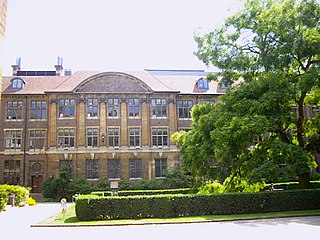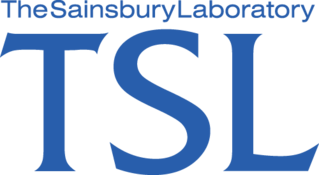
The Department of Plant Sciences is a department of the University of Cambridge that conducts research and teaching in plant sciences. It was established in 1904, although the university has had a professor of botany since 1724.

The John Innes Centre (JIC), located in Norwich, Norfolk, England, is an independent centre for research and training in plant and microbial science founded in 1910. It is a registered charity grant-aided by the Biotechnology and Biological Sciences Research Council (BBSRC), the European Research Council (ERC) and the Bill and Melinda Gates Foundation and is a member of the Norwich Research Park. In 2017, the John Innes Centre was awarded a gold Athena SWAN Charter award for equality in the workplace.
Biotechnology and Biological Sciences Research Council (BBSRC), part of UK Research and Innovation, is a non-departmental public body (NDPB), and is the largest UK public funder of non-medical bioscience. It predominantly funds scientific research institutes and university research departments in the UK.

Sir David Charles Baulcombe is a British plant scientist and geneticist. As of 2017 he is a Royal Society Research Professor. From 2007 to 2020 he was Regius Professor of Botany in the Department of Plant Sciences at the University of Cambridge.

The Sainsbury Laboratory (TSL) is a research institute located at the Norwich Research Park in Norwich, Norfolk, England, that carries out fundamental biological research and technology development on aspects of plant disease, plant disease resistance and microbial symbiosis in plants.

Dame Caroline Dean is a British plant scientist working at the John Innes Centre. She is focused on understanding the molecular controls used by plants to seasonally judge when to flower. She is specifically interested in vernalisation — the acceleration of flowering in plants by exposure to periods of prolonged cold. She has also been on the Life Sciences jury for the Infosys Prize from 2018.
The School of Biological Sciences is a research-led academic community at the University of East Anglia. It works with partners in industry on a range of activities, including translating research discoveries into products, making knowledge and research expertise available through consultancies, contract research and provision of analytical services, as well as partnering industry in training both undergraduate and postgraduate students.

Norwich Research Park is a business community located to the southwest of Norwich in East Anglia close to the A11 and the A47 roads. Set in over 230 hectares of parkland, Norwich Research Park is home to over 12,000 people, including 3,000 researchers and clinicians with an annual research spend of over £130 million. The focus of the community is on creating and supporting new companies and jobs based on bioscience.

Catherine Rosemary Martin is a Professor of Plant Sciences at the University of East Anglia (UEA) and project leader at the John Innes Centre, Norwich, co-ordinating research into the relationship between diet and health and how crops can be fortified to improve diets and address escalating chronic disease globally.
Michael Webster Bevan is a professor at the John Innes Centre, Norwich, UK.

Alison Mary Smith is a British biologist. She is Strategic Programme Leader at the John Innes Centre in Norwich and an Honorary Professor at the University of East Anglia (UEA) in the UK.

Anne Jacqueline Ridley is professor of Cell Biology and Head of School for Cellular and Molecular Medicine at the University of Bristol. She was previously a professor at King's College London.
Susan RosserFRSB FLSW is a professor of Synthetic Biology at the University of Edinburgh.
Sarah E. O'Connor is an American molecular biologist working to understand the molecular machinery involved in assembling important plant natural products – vinblastine, morphine, iridoids, secologanin – and how changing the enzymes involved in this pathway lead to diverse analogs. She was a Project Leader at the John Innes Centre in the UK between 2011 and 2019. O'Connor was appointed by the Max Planck Society in 2018 to head the Department of Natural Product Biosynthesis at the Max Planck Institute for Chemical Ecology in Jena, Germany, taking up her role during 2019.
Elizabeth S. Sattely is an American scientist and biotechnology engineer. She is an Associate Professor of Chemical Engineering in the Department of Chemical Engineering, an HHMI investigator, and a ChEM-H Faculty Fellow at Stanford University.

Yiliang Ding has been a group leader with tenure at the John Innes Centre since 2014, working on the functional roles of the RNA structure in living cells. She has also been an Honorary Group Leader at the Babraham Institute and an Honorary Associate Professor at the University of East Anglia since 2022.
Nicola Stanley-Wall FRSE FRSB is a Professor of Microbiology in the School of Life Sciences at the University of Dundee who works on the molecular mechanism of biofilm formation. Her laboratory investigates how bacteria come together to form social communities called biofilms. More specifically, her research analyses the way the molecules in the biofilm matrix provide support and protection to biofilms formed by the Gram-positive bacterium Bacillus subtilis.
Jane Osbourn, OBE, is a scientist and former chair of the UK BioIndustry Association.

Eriko Takano is a professor of synthetic biology and a director of the Synthetic Biology Research Centre for Fine and Speciality Chemicals (SYNBIOCHEM) at the University of Manchester. She develops antibiotics and other high-value chemicals using microbial synthetic biology tools.
Diane G. O. Saunders is a British biologist and group leader at the John Innes Centre and an Honorary Professor in the School of Biological Sciences at the University of East Anglia. Her research investigates plant pathogens that pose a threat to agriculture. She was awarded the Rosalind Franklin Award by the Royal Society in 2022.











